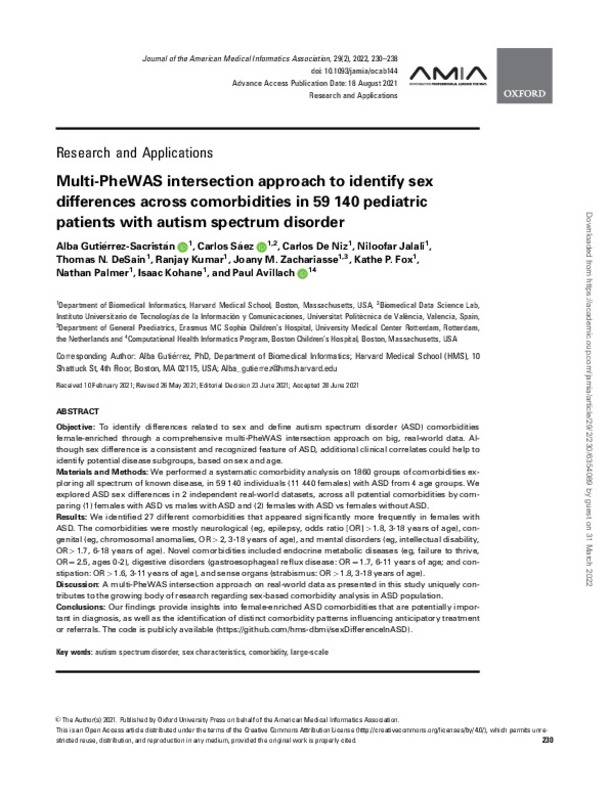JavaScript is disabled for your browser. Some features of this site may not work without it.
Buscar en RiuNet
Listar
Mi cuenta
Estadísticas
Ayuda RiuNet
Admin. UPV
Multi-PheWAS intersection approach to identify sex differences across comorbidities in 59 140 pediatric patients with autism spectrum disorder
Mostrar el registro sencillo del ítem
Ficheros en el ítem
| dc.contributor.author | Gutiérrez-Sacristán, Alba
|
es_ES |
| dc.contributor.author | Sáez Silvestre, Carlos
|
es_ES |
| dc.contributor.author | de Niz, Carlos
|
es_ES |
| dc.contributor.author | Jalali, Niloofar
|
es_ES |
| dc.contributor.author | DeSain, Thomas N.
|
es_ES |
| dc.contributor.author | Kumar, Ranjay
|
es_ES |
| dc.contributor.author | Zachariasse, Joany M.
|
es_ES |
| dc.contributor.author | Fox, Kathe P.
|
es_ES |
| dc.contributor.author | Palmer, Nathan
|
es_ES |
| dc.contributor.author | Kohane, Isaac
|
es_ES |
| dc.contributor.author | Avillach, Paul
|
es_ES |
| dc.date.accessioned | 2023-10-11T18:02:06Z | |
| dc.date.available | 2023-10-11T18:02:06Z | |
| dc.date.issued | 2021-02 | es_ES |
| dc.identifier.issn | 1067-5027 | es_ES |
| dc.identifier.uri | http://hdl.handle.net/10251/198021 | |
| dc.description.abstract | [EN] Objective: To identify differences related to sex and define autism spectrum disorder (ASD) comorbidities female-enriched through a comprehensive multi-PheWAS intersection approach on big, real-world data. Although sex difference is a consistent and recognized feature of ASD, additional clinical correlates could help to identify potential disease subgroups, based on sex and age. Materials and Methods: We performed a systematic comorbidity analysis on 1860 groups of comorbidities exploring all spectrum of known disease, in 59 140 individuals (11 440 females) with ASD from 4 age groups. We explored ASD sex differences in 2 independent real-world datasets, across all potential comorbidities by comparing (1) females with ASD vs males with ASD and (2) females with ASD vs females without ASD. Results: We identified 27 different comorbidities that appeared significantly more frequently in females with ASD. The comorbidities were mostly neurological (eg, epilepsy, odds ratio [OR]>1.8, 3-18 years of age), congenital (eg, chromosomal anomalies, OR>2, 3-18 years of age), and mental disorders (eg, intellectual disability, OR>1.7, 6-18 years of age). Novel comorbidities included endocrine metabolic diseases (eg, failure to thrive, OR=2.5, ages 0-2), digestive disorders (gastroesophageal reflux disease: OR=1.7, 6-11 years of age; and constipation: OR>1.6, 3-11 years of age), and sense organs (strabismus: OR>1.8, 3-18 years of age). Discussion: A multi-PheWAS intersection approach on real-world data as presented in this study uniquely contributes to the growing body of research regarding sex-based comorbidity analysis in ASD population. Conclusions: Our findings provide insights into female-enriched ASD comorbidities that are potentially important in diagnosis, as well as the identification of distinct comorbidity patterns influencing anticipatory treatment or referrals. | es_ES |
| dc.description.sponsorship | This work has been supported by the National Institutes of Health BD2K grant U54HG007963. JMZ received grants from Stichting de Drie Lichten and Stichting Sophia Kinderziekenhuis Fonds for a research internship at Harvard Medical School. | es_ES |
| dc.language | Inglés | es_ES |
| dc.publisher | Oxford University Press | es_ES |
| dc.relation.ispartof | Journal of the American Medical Informatics Association | es_ES |
| dc.rights | Reconocimiento (by) | es_ES |
| dc.subject | Autism spectrum disorder | es_ES |
| dc.subject | Sex characteristics | es_ES |
| dc.subject | Comorbidity | es_ES |
| dc.subject | Large-scale | es_ES |
| dc.subject.classification | FISICA APLICADA | es_ES |
| dc.title | Multi-PheWAS intersection approach to identify sex differences across comorbidities in 59 140 pediatric patients with autism spectrum disorder | es_ES |
| dc.type | Artículo | es_ES |
| dc.identifier.doi | 10.1093/jamia/ocab144 | es_ES |
| dc.relation.projectID | info:eu-repo/grantAgreement/NIH//U54HG007963/ | es_ES |
| dc.rights.accessRights | Abierto | es_ES |
| dc.contributor.affiliation | Universitat Politècnica de València. Escuela Técnica Superior de Ingenieros Industriales - Escola Tècnica Superior d'Enginyers Industrials | es_ES |
| dc.description.bibliographicCitation | Gutiérrez-Sacristán, A.; Sáez Silvestre, C.; De Niz, C.; Jalali, N.; Desain, TN.; Kumar, R.; Zachariasse, JM.... (2021). Multi-PheWAS intersection approach to identify sex differences across comorbidities in 59 140 pediatric patients with autism spectrum disorder. Journal of the American Medical Informatics Association. 29(2):230-238. https://doi.org/10.1093/jamia/ocab144 | es_ES |
| dc.description.accrualMethod | S | es_ES |
| dc.relation.publisherversion | https://doi.org/10.1093/jamia/ocab144 | es_ES |
| dc.description.upvformatpinicio | 230 | es_ES |
| dc.description.upvformatpfin | 238 | es_ES |
| dc.type.version | info:eu-repo/semantics/publishedVersion | es_ES |
| dc.description.volume | 29 | es_ES |
| dc.description.issue | 2 | es_ES |
| dc.identifier.pmid | 34405856 | es_ES |
| dc.identifier.pmcid | PMC8757290 | es_ES |
| dc.relation.pasarela | S\459971 | es_ES |
| dc.contributor.funder | Harvard University | es_ES |
| dc.contributor.funder | Stichting de Drie Lichten | es_ES |
| dc.contributor.funder | Stichting Vrienden van het Sophia | es_ES |
| dc.contributor.funder | National Institutes of Health, EEUU | es_ES |








